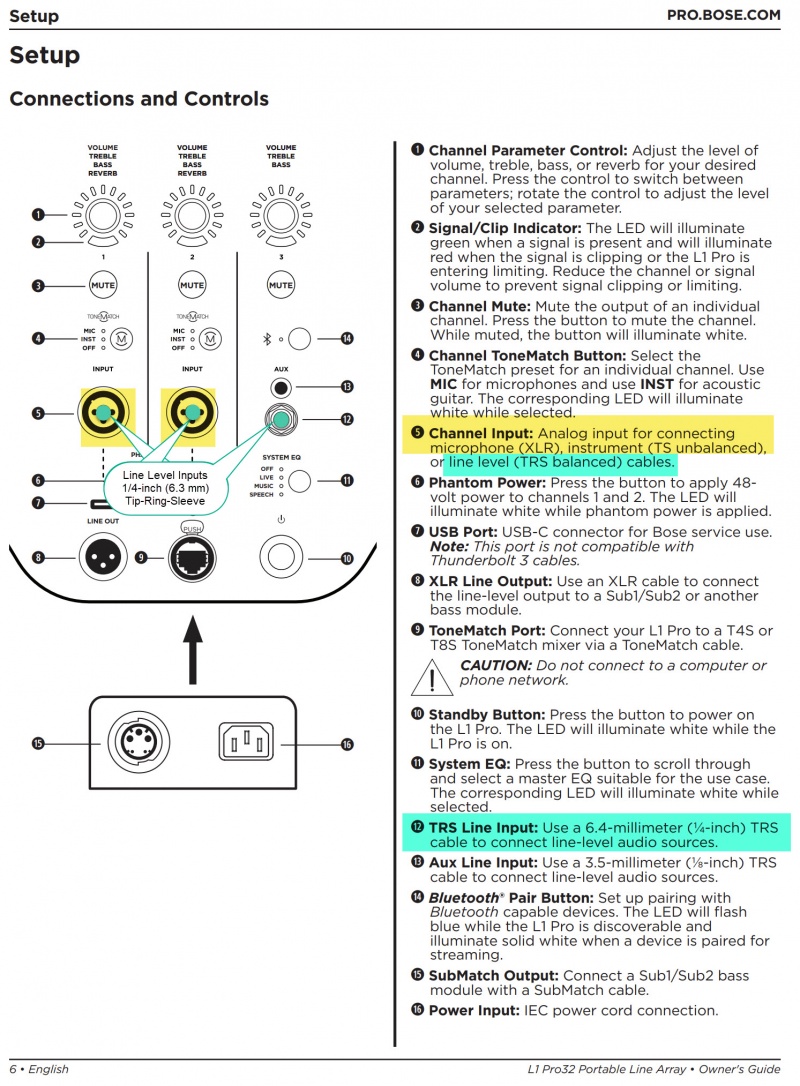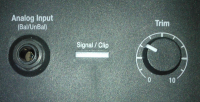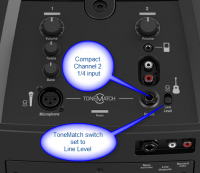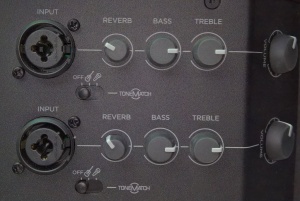Difference between revisions of "XLR Cables - Technical Discussion"
DanCornett (talk | contribs) m |
m (formatting) |
||
| (One intermediate revision by the same user not shown) | |||
| Line 13: | Line 13: | ||
For this "antenna effect" to work, the cable must only have its shield connected at one end, not both. This *is* common practice with most good XLR cables, but it is far less common with 1/4" cables. That's why XLR cables are generally preferred for long distance runs ... even if being used for an "unbalanced" signal. Unless you take apart the 1/4" connectors at both ends to see how the shielding is connected (or not), you really can't reliably depend on mixing-and-matching 1/4" cables ... but you can (generally) depend on good XLR cables to be properly shielded. | For this "antenna effect" to work, the cable must only have its shield connected at one end, not both. This *is* common practice with most good XLR cables, but it is far less common with 1/4" cables. That's why XLR cables are generally preferred for long distance runs ... even if being used for an "unbalanced" signal. Unless you take apart the 1/4" connectors at both ends to see how the shielding is connected (or not), you really can't reliably depend on mixing-and-matching 1/4" cables ... but you can (generally) depend on good XLR cables to be properly shielded. | ||
| − | + | ---- | |
There are a lot more subtleties about cabling, but that's the (non-pictorial) essence of the wiring terms "balanced/unbalanced" and "shielded". | There are a lot more subtleties about cabling, but that's the (non-pictorial) essence of the wiring terms "balanced/unbalanced" and "shielded". | ||
| − | + | ---- | |
'''''If the ground is common to both pieces of connected equipment, why would it matter if both ends of a shield were connected? Now I'm confused.''''' | '''''If the ground is common to both pieces of connected equipment, why would it matter if both ends of a shield were connected? Now I'm confused.''''' | ||
| Line 41: | Line 41: | ||
Ideally, the external shell is connected to the cable shielding at both ends, and is connected to an independent "shield ground path" on the equipment at both ends, so that the "antenna" (induced) currents from that cable shield never enter the "reference ground" (signal ground) used by the circuitry at each end of the cable. All three pins on the connecter are connected; if pin 1 is not connected, that could be an unsafe cable to use! | Ideally, the external shell is connected to the cable shielding at both ends, and is connected to an independent "shield ground path" on the equipment at both ends, so that the "antenna" (induced) currents from that cable shield never enter the "reference ground" (signal ground) used by the circuitry at each end of the cable. All three pins on the connecter are connected; if pin 1 is not connected, that could be an unsafe cable to use! | ||
| − | However, as a user -- do you know what the manufacturer has done with the "shell/chassis" ground and the "signal ground"??? Not knowing that ... and knowing that manufacturers disagree on the best | + | However, as a user -- do you know what the manufacturer has done with the "shell/chassis" ground and the "signal ground"??? Not knowing that ... and knowing that manufacturers disagree on the best practises for doing so ... one can get all sorts of variations of grounding, as in Figure 5 in that [http://www.rane.com/note151.html Rane article]. |
| − | + | ---- | |
So, other than throwing up one's hands in frustration, what can we non-wiring-technician end-users do? | So, other than throwing up one's hands in frustration, what can we non-wiring-technician end-users do? | ||
| Line 54: | Line 54: | ||
Here is a pointer to a commentary on the standards -- even the professionals don't agree on the best and safest way to handle XLR connections, grounding, and shielding. [http://www.aes.org/standards/b_comments/comments-draft-aes48-xxxx.cfm (Comments on shielding/grounding standards.)] | Here is a pointer to a commentary on the standards -- even the professionals don't agree on the best and safest way to handle XLR connections, grounding, and shielding. [http://www.aes.org/standards/b_comments/comments-draft-aes48-xxxx.cfm (Comments on shielding/grounding standards.)] | ||
| + | |||
| + | {{:Balanced vs Unbalanced}} | ||
[[Category:Reference]] | [[Category:Reference]] | ||
Latest revision as of 21:59, 18 July 2007
What does it mean to have "balanced" vs. "unbalanced" cables and connections?
Balanced: What this really means is that there are TWO wires carrying a varying signal, not just one. There has to be a "reference", which is provided by the 'ground' -- hence a third wire. The advantage of a "balanced" signal is that one can get a better "signal-to-noise" ratio because the receiving amplifier is looking at the difference between the two signal wires, rather than just the difference between one wire and "ground". That's why a "balanced" system (balanced output, 3-wire cable, balanced receiving input) can be better at rejecting any "noise" which might exist between the 'sender' and the 'receiver' -- and the longer the cables, the more of a problem the "induced noise" might be.
All those 'features' cease to exist when one end or the other is 'unbalanced' -- when only one wire (signal) is compared to the reference (ground).
Unbalanced is NOT bad ... balanced signals are just one way to help deal with "difficult" situations.
By the way: with balanced cabling, doing a "ground lift" means that the "third wire" is removed, and thus the 'sender' and 'receiver' are comparing the two "signal wires" to their separate local "ground" reference, rather than sharing a common "ground" reference. If the two local "ground" references are too different, that can cause safety and/or signal quality problems -- which is why 'ground lift' has to be done with care, and is typically a "last resort" solution.
Shielding: Shielding is a means of reducing, or "side-tracking", or "shunting aside", any unwanted signals (induced noise) BEFORE it has a chance to affect the signal-carrying wire(s). The shield, thus, tries to act like an "antenna" for any external electrical signals, but it's "output" is shunted aside to the "ground" before it has a chance to affect the signal wires.
For this "antenna effect" to work, the cable must only have its shield connected at one end, not both. This *is* common practice with most good XLR cables, but it is far less common with 1/4" cables. That's why XLR cables are generally preferred for long distance runs ... even if being used for an "unbalanced" signal. Unless you take apart the 1/4" connectors at both ends to see how the shielding is connected (or not), you really can't reliably depend on mixing-and-matching 1/4" cables ... but you can (generally) depend on good XLR cables to be properly shielded.
There are a lot more subtleties about cabling, but that's the (non-pictorial) essence of the wiring terms "balanced/unbalanced" and "shielded".
If the ground is common to both pieces of connected equipment, why would it matter if both ends of a shield were connected? Now I'm confused.
You're not alone ... the difference between shield and ground can seem rather esoteric, but -- if there is a lot of "electrical noise" in the vicinity of the cables, it's an important factor.
The basic problem is that the "power ground" (also know as "chassis ground") can fluctuate (vary) -- even within a single piece of equipment ... but with microphone-level signals, that variation can show up as 'noise'. Therefore, circuit designers often put some effort into ensuring that the "signal ground" used by the electronics is stable and "clean".
When it comes to connecting the shield and signal ground, there are 4 variations -- all with advantages and disadvantages, as succintly explained here. Note that the primary "concerns" of that author seem to be frequencies ABOVE audio frequencies (100kHz and up).
Even manufacturer's literature is not always consistent about this. For example, this otherwise good Rane article on Grounding and Shielding has some sections where it seem rather confusing whether the reference is to the cable shield or the equipment shield. However, Figure 5 in that article is somewhat useful, showing all the grounding permutations and which are helpful for audio. Notice, however, that Rane article is refering to a TWO WIRE cable, not a three-wire cable! Two wire cables are common with TRS (e.g.: 1/4" or 1/8") cables, but some XLR (mic) cables are three-wire cables. Remember that TRS cables can be used to carry either stereo signals (as in most home audio equipment) or a mono-but-balanced signal (as found, for example, with some electronic keyboards) -- that can further confuse the issues of the "ground" vs. "shield" and "balanced" vs. "unbalanced".
As an aside: VIDEO cabling is almost always a single conductor with one (or more!) shield(s). The shield(s) in these cables act as both the signal reference/ground and as an interference shield.
So, an XLR-type connector and a TRS connector can both carry a balanced signal: two "hot" wires and a ground/reference connection. Where they differ is in how they can handle any shielding around the wire.
Physically, the XLR connector can provide FOUR different connections: the 3 pins and the external metal "shell". A TRS connector can only provide 3 connections. That's where differences in handling the ground vs the shield happen.
So, with XLR connectors, the issues are: what, if anything, is connected to the external "shell"? Is there a separate wire for the third pin (pin 1)? Should the cable shield (or chassis ground) also be connected to that third pin?
To further confuse things, the Wikipedia reference to EIA Standard RS-297-A says that third pin (actually, numbered pin 1) is used for chassis ground -- but doesn't reference the SIGNAL ground at all -- but one of the referenced links points to a manufacturer's diagram which shows pin 1 as a SIGNAL connection, and the shell is not connected to chassis ground!
Ideally, the external shell is connected to the cable shielding at both ends, and is connected to an independent "shield ground path" on the equipment at both ends, so that the "antenna" (induced) currents from that cable shield never enter the "reference ground" (signal ground) used by the circuitry at each end of the cable. All three pins on the connecter are connected; if pin 1 is not connected, that could be an unsafe cable to use!
However, as a user -- do you know what the manufacturer has done with the "shell/chassis" ground and the "signal ground"??? Not knowing that ... and knowing that manufacturers disagree on the best practises for doing so ... one can get all sorts of variations of grounding, as in Figure 5 in that Rane article.
So, other than throwing up one's hands in frustration, what can we non-wiring-technician end-users do?
My recommendations are to use XLR-to-XLR for balanced signals whenever radio noise or hum are a problem. If you need to use TRS connectors for the equipment connections at either end, ... and a simple TS line-level cable isn't working adequately ... then use a TRS-to-XLR (or TS-to-XLR) device (a.k.a. a "direct box) along with XLR cables. If that TRS-to-XLR device has a "ground lift", then you should be able to deal with any 'hum'/ground-loop situations.
Ideally, use XLR cables which have 3 wires connected to the three pins at each end, and the cable shield is connected to the shell at one end. If it is connected to the shell at both ends, that's o.k. -- but preferably not also connected to "pin 1" at both ends. You can't change what the manufacturers do inside the box, but you can control the type of cable used.
The best mic / XLR cabling I've used actually has 8 internal wires, configured as 4 twisted pairs with those 4 pairs ALSO twisted into pairs, plus a shield. Twisted pairs of wires are an additional means of rejecting induced noise (which is why most cables with 2 or more wires are typically "twisted" together). The XLR connector has each signal pin (2 & 3) connected to both wires of a twisted pair, rather than a single wire. Pin 1 (signal ground) is connected to the remaining 4 wires (the other pair of pairs) and the shield is only connected to the shell. Relatively expensive to make, but utterly reliable.
Here is a pointer to a commentary on the standards -- even the professionals don't agree on the best and safest way to handle XLR connections, grounding, and shielding. (Comments on shielding/grounding standards.)
Introduction
When talking about cables the terms Stereo, Mono, Balanced, Unbalanced refer to applications (how a cable is being used).
XLR, Tip-Ring-Sleeve, Tip-Sleeve are terms that refer to the physical connectors at the ends of the wires and how those wires are attached to the connectors.
It's important to use the correct connections to support your application or you may end up with poor results. For example, if you connect a stereo signal to a balanced input, you may hear very little, or just effects with none of the original signal.
Confusion About Plugs and Jacks
One source of confusion is that a cable with a 1/4 inch (6.35 mm) Tip-Ring-Sleeve jack on one end may be used for several applications (examples)
- Stereo headphones (left and right sides of a stereo signal)
- Mono balanced connection (hot and cold signals)
- Insert (send and return)
Whether or not a cable with a 1/4 inch (6.35 mm) Tip-Ring-Sleeve plug is stereo or balanced (mono) or an insert cable depends on how it is being used and the electronic interfaces at both ends of the connection.
Balanced Connections Preferred When Possible
- If both ends of a connection support balanced connections, then use a balanced cable (3 common options below).
- XLR to XLR
- 1/4 inch (6.3 mm) Tip-Ring-Sleeve
- XLR to 1/4 inch (6.3 mm) Tip-Ring-Sleeve
- Note
An unbalanced connection can be -6 dB lower signal level than a to balanced connection.
Background Information
- A balanced electrical signal runs along three wires: a ground, a positive leg, and a negative leg. Both legs carry the same signal but in opposite polarity to each other. Any noise picked up along the cable run will typically be common to both legs. Assuming the destination is balanced, the receiving device will flip one signal and put the two signals back into polarity with each other. This causes the common noise to be out of phase with itself, thus being eliminated. This noise cancellation is called Common Mode Rejection and is the reason balanced lines are generally best for long cable runs. XLR and Tip-Ring-Sleeve cables are used to transmit balanced audio from one balanced device to another.
- Unbalanced cables are less complicated, but they’re much more susceptible to noise problems. In general, unbalanced lines should be kept as short as possible (certainly under 25 feet) to minimize any potential noise that may be carried with the signal into the connected equipment.
Source: [1]
DO NOT Connect a Stereo Source to a Balanced Input
If you connect a stereo signal to a balanced input, you may hear very little, or just effects with none of the original signal. A balanced input will take the left and right signals from a stereo source and combine them with reversed polarity (this is how balanced connections work). The result is sounds that are panned in the center (typically, vocals, drums, bass) will be cancelled.
Connections between Bose Portable PA Systems
Overview: All Connections are Balanced
All line-level connections between Bose Portable PA systems are balanced***. Where possible, use a 1/4 inch (6.35 mm) Tip-Ring-Sleeve or XLR cable to make a balanced connection. Using an unbalanced connection may lead to up to -6 dB lower signal.
- ToneMatch mixers: The analog outputs (Main and Aux outputs) are balanced
- Power Stands: The 1/4 inch (6.35 mm) Tip-Ring-Sleeve inputs are balanced L1 Model 1S, L1 Model II, L1 Compact channel 2 1/4 inch (6.35 mm) Tip-Ring-Sleeve
- S1 Pro System: The channel 1 and 2 inputs are balanced
- For all Daisy Chain connections, use a balanced connection if possible. Most of the time that will be a 1/4 inch (6.35 mm) Tip-Ring-Sleeve
- ***Exception: All 1/4 inch (6.3 mm) inputs on the L1 Classic/L1 Model I are unbalanced
T4S ToneMatch mixer
- Channels 1, 2, 3, 4 XLR inputs are balanced.
- Channels 1, 2, 3, 4 ¼ inch (6 mm) jacks are balanced
- They will accept 1/4 inch (6.35 mm) Tip-Sleeve jack Tip-Sleeve connections and the connections will be unbalanced.
- Channels 5 and 6 are balanced, but will accept 1/4 inch (6.35 mm) Tip-Sleeve jack Tip-Sleeve.
If you use a 1/4 inch (6.35 mm) Tip-Ring-Sleeve from a balanced source, the connection will be balanced.
If you use a 1/4 inch (6.35 mm) Tip-Ring-Sleeve from an unbalanced source, the connection will be unbalanced.
If you use a 1/4 inch (6.35 mm) Tip-Sleeve from a balanced or unbalanced source, the connection will be unbalanced.
If you have a balanced source then using a balanced connection (XLR or 1/4 inch (6.35 mm) Tip-Ring-Sleeve) is preferable.
T8S ToneMatch mixer
- Channels 1, 2, 3, 4, 5, 6, 7, 8 XLR inputs are balanced.
- Channels 1, 2, 3, 4, 5, 6, 7, 8 ¼ inch (6 mm) jacks are balanced
- They will accept 1/4 inch (6.35 mm) Tip-Sleeve jack Tip-Sleeve connections and the connections will be unbalanced.
- Channels 9 and 10 are balanced, but will accept 1/4 inch (6.35 mm) Tip-Sleeve jack Tip-Sleeve.
If you use a 1/4 inch (6.35 mm) Tip-Ring-Sleeve from a balanced source, the connection will be balanced.
If you use a 1/4 inch (6.35 mm) Tip-Ring-Sleeve from an unbalanced source, the connection will be unbalanced.
If you use a 1/4 inch (6.35 mm) Tip-Sleeve from a balanced or unbalanced source, the connection will be unbalanced.
If you have a balanced source then using a balanced connection (XLR or 1/4 inch (6.35 mm) Tip-Ring-Sleeve) is preferable.
T1 ToneMatch Audio Engine
- Channels 1, 2, 3 XLR inputs are balanced.
- Channels 1, 2, 3 1/4" jacks are unbalanced (but will accept 1/4 inch (6.35 mm) Tip-Ring-Sleeve) the connections are still unbalanced.
- Channels 4/5 are balanced, but will accept ¼ inch jack Tip-Sleeve.
If you use a 1/4 inch (6.35 mm) Tip-Ring-Sleeve cable from a balanced source, the connection will be balanced.
If you use a 1/4 inch (6.35 mm) Tip-Ring-Sleeve cable from an unbalanced source, the connection will be unbalanced.
If you use a &1/4 inch (6.35 mm) Tip-Sleeve cable from a balanced or unbalanced source, the connection will be unbalanced.
If you have a balanced source then using a balanced connection (XLR or ¼ inch jack Tip-Ring-Sleeve) is preferable.
L1 Pro (all models)
L1 Model II
- Model II Power Stand Analog input is balanced.
It will accept ¼ inch jack Tip-Sleeve.
If you use a 1/4 inch (6.35 mm) Tip-Ring-Sleeve cable from a balanced source, the connection will be balanced.
If you use a 1/4 inch (6.35 mm) Tip-Ring-Sleeve cable from an unbalanced source, the connection will be unbalanced.
If you use a ¼ inch jack Tip-Sleeve from a balanced or unbalanced source, the connection will be unbalanced.
If you have a balanced source then using a balanced connection (XLR or ¼ inch jack Tip-Ring-Sleeve) is preferable.
L1 Model 1S
- Model II Power Stand Analog input is balanced.
It will accept ¼ inch jack Tip-Sleeve.
If you use a 1/4 inch (6.35 mm) Tip-Ring-Sleeve cabe; from a balanced source, the connection will be balanced.
If you use a 1/4 inch (6.35 mm) Tip-Ring-Sleeve cable from an unbalanced source, the connection will be unbalanced.
If you use a 1/4 inch (6.35 mm) Tip-Sleeve cable from a balanced or unbalanced source, the connection will be unbalanced.
If you have a balanced source then using a balanced connection (XLR or ¼ inch jack Tip-Ring-Sleeve) is preferable.
L1 Compact
Compact Channel 2 1/4 inch (6.35 mm) Tip-Ring-Sleeve input is balanced.
It will accept 1/4 inch (6.35 mm) Tip-Sleeve cables.
If you use a 1/4 inch (6.35 mm) Tip-Ring-Sleeve cable from a balanced source, the connection will be balanced.
If you use a 1/4 inch (6.35 mm) Tip-Ring-Sleeve cable from an unbalanced source, the connection will be unbalanced.
If you use a 1/4 inch (6.35 mm) Tip-Sleeve cable from a balanced or unbalanced source, the connection will be unbalanced.
If you have a balanced source then using a balanced connection (XLR or 1/4 inch (6.35 mm) Tip-Ring-Sleeve cable) is preferable.
S1 Pro System
S1 Pro Combo Inputs 1/4 inch (6.35 mm) Tip-Ring-Sleeve jack and XLR are balanced.
They will accept 1/4 inch (6.35 mm) Tip-Ring-Sleeve or 1/4 inch (6.35 mm) Tip-Sleeve jacks.
If you use a 1/4 inch (6.35 mm) Tip-Ring-Sleeve cable from a balanced source, the connection will be balanced.
If you use a 1/4 inch (6.35 mm) Tip-Ring-Sleeve cable from an unbalanced source, the connection will be unbalanced.
If you use a 1/4 inch (6.35 mm) Tip-Sleeve from a balanced or unbalanced source, the connection will be unbalanced.
If you have a balanced source then using a balanced connection (XLR or 1/4 inch (6.35 mm) Tip-Ring-Sleeve) is preferable.
References
Unbalanced vs. Balanced Lines - Whirlwind
Interconnection of Balanced and Unbalanced Equipment Bill Whitlock, Jensen Transformers.
Sound System Interconnection RaneNote 110
Balanced, Unbalanced, Stereo? what are they? Sweetwater.com > Frequently Asked Questions
Balanced vs Unbalanced Interconnects audioholics.com
What's the Difference Between Balanced and Unbalanced aviom.com








